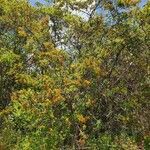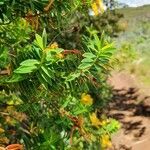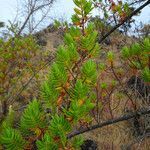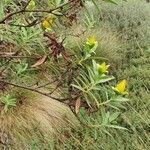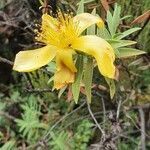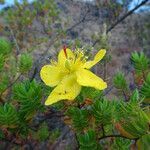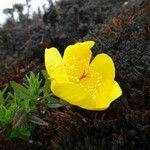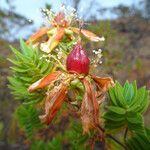Shrub up to 3 m high (12 m in tropical Africa). Stems 4-angled when young, but becoming ± terete, often with scaly bark. Leaves sessile, narrowly elliptic, 0.8-2.5 cm long, 3-6 mm wide, apex acute, base cuneate, narrowing to a clasping base, venation sparsely pinnate, tertiary venation variously conspicuous, with translucent longitudinal glands or striae and few dark submarginal glands. Flowers solitary, terminal. Sepals unequal, ovate, 6-10 mm long, 5 mm wide, concave, with few dark submarginal glands and often numerous stalked marginal glands. Petals obovate-spathulate, 2-3 cm long, 0.8-1.8 cm wide, yellow, without dark submarginal gland dots. Stamens in 5 bundles of 20-30 each; filaments 8-15 mm long; anthers c. 1-1.3 mm long, with apical gland. Ovary ovoid, 4-6 mm long, 3-5 mm wide; styles 5, 4-8 mm long, united except for upper 1.5-4 mm. Capsule ovoid, 1-1.2 cm long, 0.7-1.1 cm wide, 5-valved.
Perennial shrub, 0.33-3.65 m high; often with scaly bark. Leaves 8-25 x 3-6 mm; sessile; elliptic; venation pinnate, tertiary venation sometimes conspicuous; translucent longitudinal gland and few dark submarginal glands. Flowers solitary, terminal. Sepals unequal; 6-10 x 3-5 mm; with dark marginal glands. Petals 20-30 x 8-18 mm; yellow; without submarginal gland dots. Stamens in 5 bundles of 20-30 each; anthers with apical gland. Ovary ovoid. Fruit a capsule.
A shrub or small tree. It grows 4-6 m high. It can grow up to 15 m high. The leaves are opposite ad crowded near the ends of branches. They are 20 mm long by 5 mm wide. They are green and do not have stalks but clasp the stems at the base. The flowers are at the ends of the branches and occur singly. They are bright yellow and 5 cm across. The fruit is a red-brown capsule. They are 13 mm long by 10 mm across.
Leaves sessile; lamina (11) 20–30 (37) × 2·5–6 (10) mm., lanceolate or oblong-lanceolate, acute at the apex, narrowing to a clasping base, with pinnate or ± reticulate venation, translucent glands (mostly longitudinal streaks or interrupted lines) and small marginal glandular dots (translucent or sometimes dark).
Petals yellow, (1·5) 2·5–3 cm. long, about 3 times as long as the sepals, often tinged with orange, with a few dark marginal dots or eglandular.
Shrub, up to 3 m high. Leaves 8-23 mm long. Styles 5, partially or wholly united. Flowers solitary at ends of branches. Flowers yellow.
Sepals ovate, somewhat concave, with dark submarginal dots, and sometimes also dark fringing glands.
Ovary 5-locular; styles 5 with only the lower parts united or almost free, 4–7 mm. long.
Much-branched evergreen shrub or tree (1) 2–6 (12) m. high, with scaly bark.
Androecium of 5 stamen-fascicles, each with c. 30 stamens.
Bracts (when present) leaflike, with dark marginal dots.
Young sterns 4-angled, soon becoming woody and terete.
Flowers solitary, terminal.
Fruit capsular, 5-valved.
